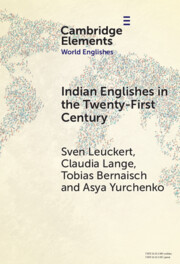67 results
Decoding Bollywood: why Hindi–English code-switching and standard English outrank Indian English
-
- Journal:
- English Language & Linguistics / Volume 28 / Issue 4 / December 2024
- Published online by Cambridge University Press:
- 25 March 2025, pp. 683-708
-
- Article
-
- You have access
- Open access
- HTML
- Export citation
Fascination with English in South Korea - Jieun Kiaer and Hyejeong Ahn, Emergence of Korean English: How Korea's Dynamic English Is Born Abingdon and New York: Routledge, 2024. Pp. xi+180. Hardback £108.00, ISBN 9781032257709, e-book £31.99, ISBN 9781003284956
-
- Journal:
- English Today , First View
- Published online by Cambridge University Press:
- 18 March 2025, pp. 1-2
-
- Article
- Export citation
A peculiar pair of festschrifts - Aloysius Ngefac, Hans–Georg Wolf and Thomas Hoffmann (eds.), World Englishes and Creole Languages Today, Vol. I: The Schneiderian Thinking and Beyond Muenchen: Lincom, 2022. Pp. 246. Hardback €178,00, ISBN: 9783 969390917. - Aloysius Ngefac, Hans–Georg Wolf and Thomas Hoffmann (eds.), World Englishes and Creole Languages Today, Vol. II: The Bobdian Thinking and Beyond Muenchen: Lincom, 2022. Pp. 270. Hardback €184,00, ISBN: 9783 969390924.
-
- Journal:
- English Today , First View
- Published online by Cambridge University Press:
- 04 March 2025, pp. 1-2
-
- Article
- Export citation
A unified perspective on the status of English in the Nordic countries - Elizabeth Peterson and Kristy Beers Fägersten, eds., English in the Nordic Countries: Connections, Tensions, and Everyday Realities New York and Oxon: Routledge, 2024. Pp. xvi+244. Paperback £29.59, ISBN: 978-1-03-222467-1
-
- Journal:
- English Today , First View
- Published online by Cambridge University Press:
- 24 February 2025, pp. 1-3
-
- Article
- Export citation
Multilingual English teachers in Asian Expanding Circle ELT: Multilingual English teachers in Asian Expanding Circle ELT: A literature review
-
- Journal:
- English Today , First View
- Published online by Cambridge University Press:
- 17 February 2025, pp. 1-8
-
- Article
-
- You have access
- Open access
- HTML
- Export citation

Multiscriptal English in Transliterated Linguistic Landscapes
-
- Published online:
- 07 February 2025
- Print publication:
- 13 February 2025
-
- Element
- Export citation

Transnational Korean Englishes
-
- Published online:
- 06 February 2025
- Print publication:
- 06 February 2025
-
- Element
- Export citation
Comparative variation analysis at cross roads: perspectives and methods - Benedikt Szmrecsanyi and Jason Grafmiller, Comparative Variation Analysis: Grammatical Alternations in World Englishes Cambridge; New York, NY: Cambridge University Press, 2023. Pp. xvii+218. Hardback $125, ISBN: 9781108491563
-
- Journal:
- English Today , First View
- Published online by Cambridge University Press:
- 30 January 2025, pp. 1-3
-
- Article
- Export citation
Beyond the ‘standard’ - Bertus van Rooy, World Englishes: The Local Lives of a Global Language. 1st ed. Edinburgh: Edinburgh University Press, 2024. Pp viii+230. Paperback, £24.99. ISBN: 9781474486309.
-
- Journal:
- English Today , First View
- Published online by Cambridge University Press:
- 23 January 2025, pp. 1-3
-
- Article
- Export citation
Improving EFL learners’ self-confidence in English-speaking performance with World Englishes teaching: A tentative study from China
-
- Journal:
- English Today / Volume 40 / Issue 4 / December 2024
- Published online by Cambridge University Press:
- 20 December 2024, pp. 283-293
- Print publication:
- December 2024
-
- Article
-
- You have access
- HTML
- Export citation
Production of English vowel duration by multilingual speakers of Namibian English: Namibian English vowel durations
-
- Journal:
- English Today / Volume 40 / Issue 3 / September 2024
- Published online by Cambridge University Press:
- 12 September 2024, pp. 185-193
- Print publication:
- September 2024
-
- Article
-
- You have access
- Open access
- HTML
- Export citation
2 - Second Language Acquisition
-
- Book:
- A Practical Guide to Second Language Teaching and Learning
- Published online:
- 03 May 2024
- Print publication:
- 30 May 2024, pp 22-46
-
- Chapter
- Export citation
An exploratory investigation of functional variation in South Asian online Englishes
-
- Journal:
- English Language & Linguistics / Volume 28 / Issue 2 / June 2024
- Published online by Cambridge University Press:
- 01 April 2024, pp. 371-400
-
- Article
-
- You have access
- Open access
- HTML
- Export citation
A topic which I want to know more about – preposition placement in finite WH-relative clauses in World Englishes
-
- Journal:
- English Language & Linguistics / Volume 28 / Issue 2 / June 2024
- Published online by Cambridge University Press:
- 15 March 2024, pp. 341-370
-
- Article
-
- You have access
- HTML
- Export citation
Rhythm in the Kingdom: a variationist analysis of speech rhythm in Tongan English
-
- Journal:
- English Language & Linguistics / Volume 28 / Issue 2 / June 2024
- Published online by Cambridge University Press:
- 12 March 2024, pp. 203-225
-
- Article
-
- You have access
- HTML
- Export citation

Teaching English as an International Language
-
- Published online:
- 20 December 2023
- Print publication:
- 01 February 2024
-
- Element
- Export citation

Indian Englishes in the Twenty-First Century
- Unity and Diversity in Lexicon and Morphosyntax
-
- Published online:
- 27 November 2023
- Print publication:
- 21 December 2023
-
- Element
- Export citation
8 - Intonation in Varieties of English
-
- Book:
- The Sounds of English Around the World
- Published online:
- 25 August 2023
- Print publication:
- 14 September 2023, pp 240-273
-
- Chapter
- Export citation
2 - The History and Spread of English Worldwide
-
- Book:
- The Sounds of English Around the World
- Published online:
- 25 August 2023
- Print publication:
- 14 September 2023, pp 14-44
-
- Chapter
- Export citation
5 - The Consonants of English
-
- Book:
- The Sounds of English Around the World
- Published online:
- 25 August 2023
- Print publication:
- 14 September 2023, pp 143-186
-
- Chapter
- Export citation


